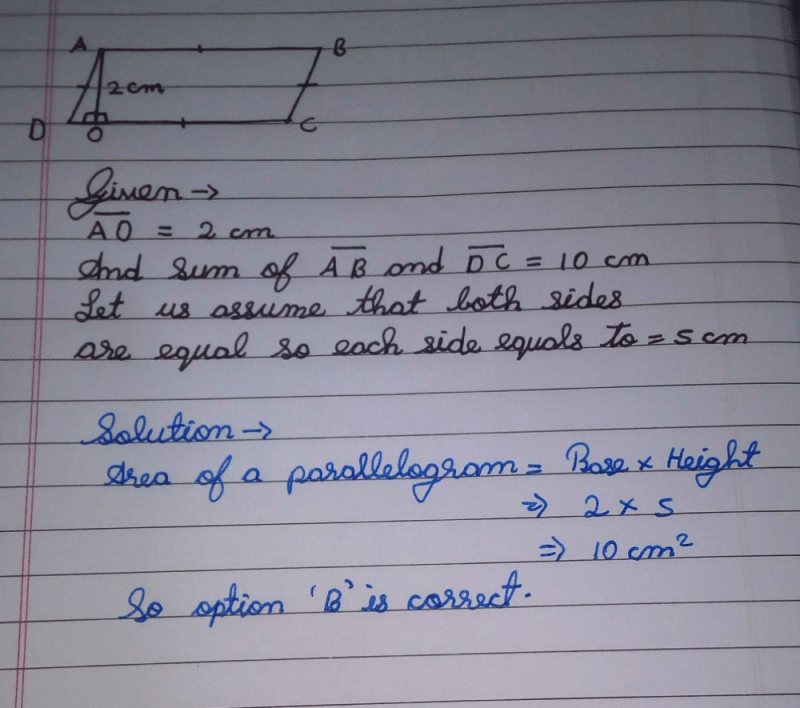Class 8 Exam > Class 8 Questions > If the parallel sides of a parallelogram are ...
Start Learning for Free
If the parallel sides of a parallelogram are 2 cm apart and their sum is 10 cm then its area is:
- a)20 cm2
- b)10 cm2
- c)5 cm2
- d)none of these
Correct answer is option 'B'. Can you explain this answer?
Verified Answer
If the parallel sides of a parallelogram are 2 cm apart and their sum ...
Distance between the two parallel lines = h =2 cm
sum of length of sides =10cm
As we know the sides of parallelogram are equal
let the length of side be 'b' =base of parallelogram
2b =10
b = 5 cm
area of parallelogram = h×b
= 2×5
=10 cm2
sum of length of sides =10cm
As we know the sides of parallelogram are equal
let the length of side be 'b' =base of parallelogram
2b =10
b = 5 cm
area of parallelogram = h×b
= 2×5
=10 cm2
Most Upvoted Answer
If the parallel sides of a parallelogram are 2 cm apart and their sum ...

Free Test
FREE
| Start Free Test |
Community Answer
If the parallel sides of a parallelogram are 2 cm apart and their sum ...
Given:
Distance between parallel sides = 2 cm
Sum of parallel sides = 10 cm
To find: Area of the parallelogram
Solution:
We know that the area of a parallelogram is given by the formula:
Area = base × height
Here, the base of the parallelogram is the distance between the parallel sides, which is given as 2 cm.
Let's find the height of the parallelogram using the given information.
Let the lengths of the parallel sides be a and b, such that a > b. Then, we have:
a + b = 10 (given)
a - b = 2 (distance between parallel sides)
Adding the above two equations, we get:
2a = 12
a = 6 cm
Substituting the value of a in either of the above two equations, we get:
b = 4 cm
Now, the height of the parallelogram can be found using the formula:
height = (area of parallelogram) / (base)
We know that the base is 2 cm, and the area is yet to be found. Let the height be h.
So, we have:
h = (area of parallelogram) / 2
And also, we know that:
area of parallelogram = base × height
Substituting the value of height in terms of area, we get:
h = (area of parallelogram) / 2
=> area of parallelogram = 2h
=> area of parallelogram = 2 × base × height
Substituting the given values, we get:
area of parallelogram = 2 × 2 × h
area of parallelogram = 4h
We need to find the value of h. Let's use the Pythagorean theorem to find it.
In the right triangle formed by the height, base, and one of the sides of the parallelogram, we have:
(base/2)^2 + h^2 = (a/2)^2
Substituting the given values, we get:
(1)^2 + h^2 = (3)^2
h^2 = 8
h = √8
h = 2√2 cm
Now, substituting the values of base and height in the formula for area, we get:
Area = base × height
Area = 2 cm × 2√2 cm
Area = 4√2 cm²
Area ≈ 5.66 cm²
Therefore, the correct option is (b) 10 cm².
Distance between parallel sides = 2 cm
Sum of parallel sides = 10 cm
To find: Area of the parallelogram
Solution:
We know that the area of a parallelogram is given by the formula:
Area = base × height
Here, the base of the parallelogram is the distance between the parallel sides, which is given as 2 cm.
Let's find the height of the parallelogram using the given information.
Let the lengths of the parallel sides be a and b, such that a > b. Then, we have:
a + b = 10 (given)
a - b = 2 (distance between parallel sides)
Adding the above two equations, we get:
2a = 12
a = 6 cm
Substituting the value of a in either of the above two equations, we get:
b = 4 cm
Now, the height of the parallelogram can be found using the formula:
height = (area of parallelogram) / (base)
We know that the base is 2 cm, and the area is yet to be found. Let the height be h.
So, we have:
h = (area of parallelogram) / 2
And also, we know that:
area of parallelogram = base × height
Substituting the value of height in terms of area, we get:
h = (area of parallelogram) / 2
=> area of parallelogram = 2h
=> area of parallelogram = 2 × base × height
Substituting the given values, we get:
area of parallelogram = 2 × 2 × h
area of parallelogram = 4h
We need to find the value of h. Let's use the Pythagorean theorem to find it.
In the right triangle formed by the height, base, and one of the sides of the parallelogram, we have:
(base/2)^2 + h^2 = (a/2)^2
Substituting the given values, we get:
(1)^2 + h^2 = (3)^2
h^2 = 8
h = √8
h = 2√2 cm
Now, substituting the values of base and height in the formula for area, we get:
Area = base × height
Area = 2 cm × 2√2 cm
Area = 4√2 cm²
Area ≈ 5.66 cm²
Therefore, the correct option is (b) 10 cm².

|
Explore Courses for Class 8 exam
|

|
Similar Class 8 Doubts
If the parallel sides of a parallelogram are 2 cm apart and their sum is 10 cm then its area is:a)20 cm2b)10 cm2c)5 cm2d)none of theseCorrect answer is option 'B'. Can you explain this answer?
Question Description
If the parallel sides of a parallelogram are 2 cm apart and their sum is 10 cm then its area is:a)20 cm2b)10 cm2c)5 cm2d)none of theseCorrect answer is option 'B'. Can you explain this answer? for Class 8 2025 is part of Class 8 preparation. The Question and answers have been prepared according to the Class 8 exam syllabus. Information about If the parallel sides of a parallelogram are 2 cm apart and their sum is 10 cm then its area is:a)20 cm2b)10 cm2c)5 cm2d)none of theseCorrect answer is option 'B'. Can you explain this answer? covers all topics & solutions for Class 8 2025 Exam. Find important definitions, questions, meanings, examples, exercises and tests below for If the parallel sides of a parallelogram are 2 cm apart and their sum is 10 cm then its area is:a)20 cm2b)10 cm2c)5 cm2d)none of theseCorrect answer is option 'B'. Can you explain this answer?.
If the parallel sides of a parallelogram are 2 cm apart and their sum is 10 cm then its area is:a)20 cm2b)10 cm2c)5 cm2d)none of theseCorrect answer is option 'B'. Can you explain this answer? for Class 8 2025 is part of Class 8 preparation. The Question and answers have been prepared according to the Class 8 exam syllabus. Information about If the parallel sides of a parallelogram are 2 cm apart and their sum is 10 cm then its area is:a)20 cm2b)10 cm2c)5 cm2d)none of theseCorrect answer is option 'B'. Can you explain this answer? covers all topics & solutions for Class 8 2025 Exam. Find important definitions, questions, meanings, examples, exercises and tests below for If the parallel sides of a parallelogram are 2 cm apart and their sum is 10 cm then its area is:a)20 cm2b)10 cm2c)5 cm2d)none of theseCorrect answer is option 'B'. Can you explain this answer?.
Solutions for If the parallel sides of a parallelogram are 2 cm apart and their sum is 10 cm then its area is:a)20 cm2b)10 cm2c)5 cm2d)none of theseCorrect answer is option 'B'. Can you explain this answer? in English & in Hindi are available as part of our courses for Class 8.
Download more important topics, notes, lectures and mock test series for Class 8 Exam by signing up for free.
Here you can find the meaning of If the parallel sides of a parallelogram are 2 cm apart and their sum is 10 cm then its area is:a)20 cm2b)10 cm2c)5 cm2d)none of theseCorrect answer is option 'B'. Can you explain this answer? defined & explained in the simplest way possible. Besides giving the explanation of
If the parallel sides of a parallelogram are 2 cm apart and their sum is 10 cm then its area is:a)20 cm2b)10 cm2c)5 cm2d)none of theseCorrect answer is option 'B'. Can you explain this answer?, a detailed solution for If the parallel sides of a parallelogram are 2 cm apart and their sum is 10 cm then its area is:a)20 cm2b)10 cm2c)5 cm2d)none of theseCorrect answer is option 'B'. Can you explain this answer? has been provided alongside types of If the parallel sides of a parallelogram are 2 cm apart and their sum is 10 cm then its area is:a)20 cm2b)10 cm2c)5 cm2d)none of theseCorrect answer is option 'B'. Can you explain this answer? theory, EduRev gives you an
ample number of questions to practice If the parallel sides of a parallelogram are 2 cm apart and their sum is 10 cm then its area is:a)20 cm2b)10 cm2c)5 cm2d)none of theseCorrect answer is option 'B'. Can you explain this answer? tests, examples and also practice Class 8 tests.

|
Explore Courses for Class 8 exam
|

|
Signup for Free!
Signup to see your scores go up within 7 days! Learn & Practice with 1000+ FREE Notes, Videos & Tests.


























